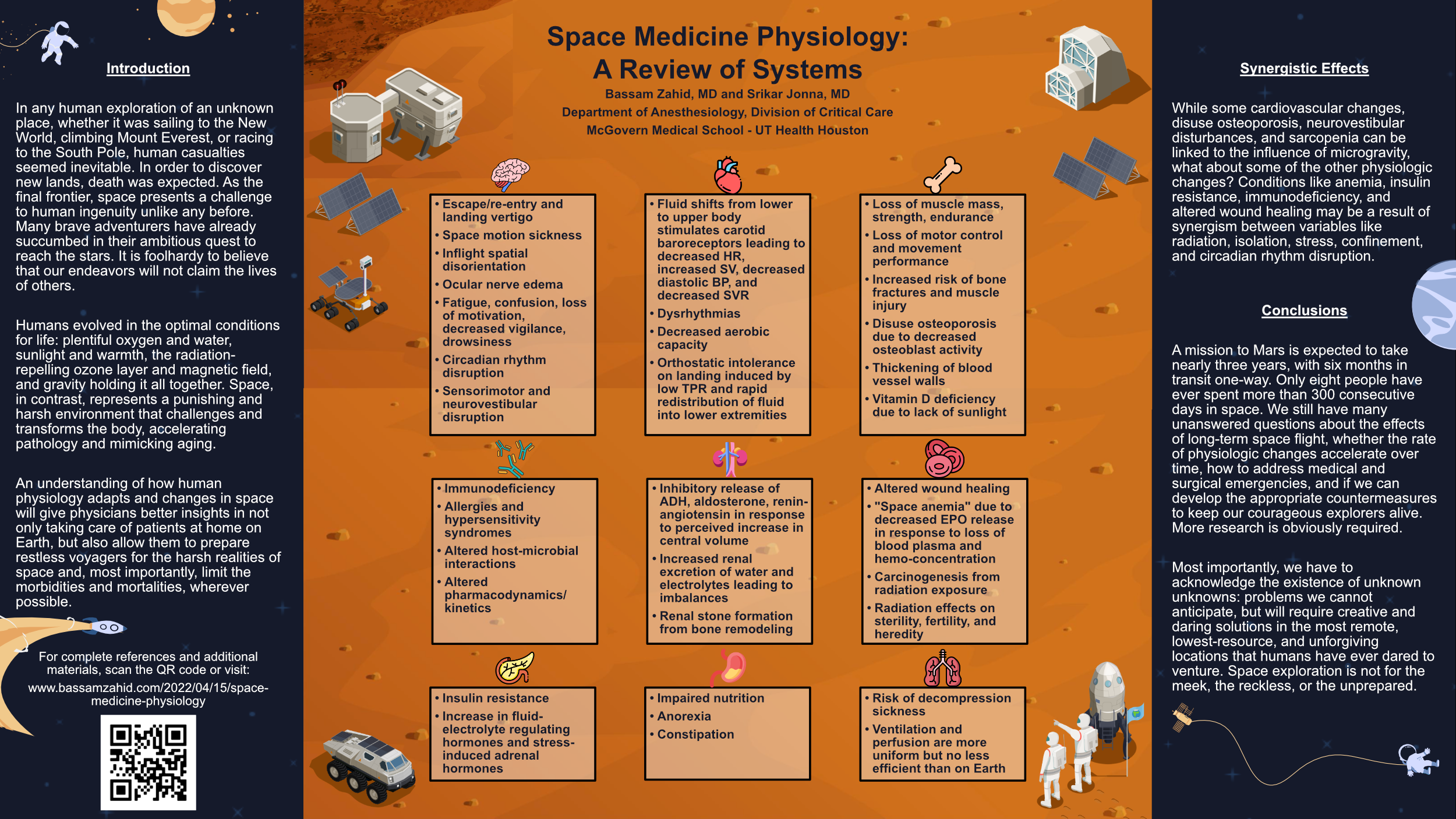
In any human exploration of an unknown place, whether it was sailing to the New World, climbing Mount Everest, or racing to the South Pole, human casualties seemed inevitable. In order to discover new lands, death was expected. As the final frontier, space presents a challenge to human ingenuity unlike any before. Many brave adventurers have already succumbed in their ambitious quest to reach the stars. It is foolhardy to believe that our endeavors will not claim the lives of others.
Humans evolved in the optimal conditions for life: plentiful oxygen and water, sunlight and warmth, the radiation-repelling ozone layer and magnetic field, and gravity holding it all together. Space, in contrast, represents a punishing and harsh environment that challenges and transforms the body, accelerating pathology and mimicking aging.
An understanding of how human physiology adapts and changes in space will give physicians better insights in not only taking care of patients at home on Earth, but also allow them to prepare restless voyagers for the harsh realities of space and, most importantly, limit the morbidities and mortalities, wherever possible.
DID YOU KNOW…
- First in space: Yuri Gagarin (USSR) on April 12, 1961 followed by Alan Shepard (USA) on May 5, 1961. The first woman was Valentina Tereshkova (USSR) on June 16, 1963
- Most consecutive days in space: 438 days by Valeri Polyakov (Russia) from January 1994 to March 1995. Followed by Sergei Avdeyev (Russia) at 379 days, and Vladimir Titov (USSR) and Musa Manarov (USSR) at 365 days. Longest by an American is 355 days by Mark Vande Hei
- Most total time in space: 878 days by Gennady Padalka (Russia)
- Greatest distance from Earth: 400,171 km when Apollo 13 successfully attempted to return home by swinging around the far side of the moon
- First space walk: Alexei Leonov (USSR) on March 18, 1965
- Most space walks in a single mission: 7 by Anatoly Solovyev (Russia) and Andrew Morgan (USA)
- Longest single space walk: 8 hours and 56 minutes by James Voss (USA) and Susan Helms (USA)
- First moon landing: Neil Armstrong (USA) and Buzz Aldrin (USA) on July 20, 1969
- Longest time on lunar surface: 74 hours and 59 minutes by Eugene Cernan (USA) and Harrison Schmitt (USA) after landing on December 11, 1972
- Most orbital launches from Earth: 7 for Jerry Ross (USA) and Franklin Chang Diaz (Costa Rica/USA)
- Youngest orbital spaceflight: Gherman Titov (USSR) at age 25
- Oldest orbital spaceflight: John Glenn (USA) at age 77
- Farthest man-made object in space: Voyager 1 at 13,820,000,000 miles from Earth as of December 2019
- Artificial objects currently in operation on Mars: Curiosity rover (NASA) since 2012, InSight lander (NASA) since 2018, Perseverance rover (NASA) since 2021, Ingenuity helicopter (NASA) since 2021, and Zhurong rover (CNSA) since 2021
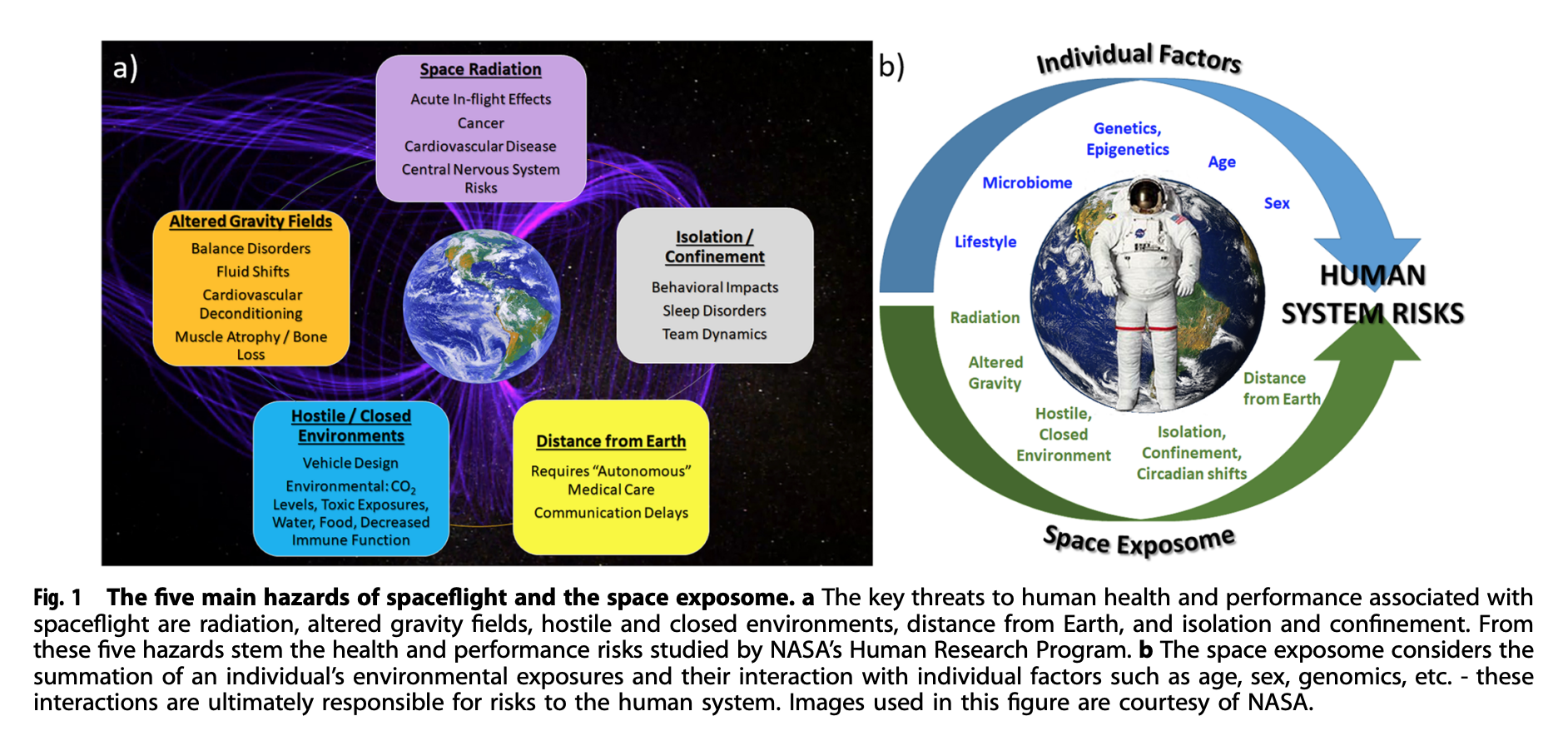
Synergistic Effects
While some cardiovascular changes, disuse osteoporosis, neurovestibular disturbances, and sarcopenia can be linked to the influence of microgravity, what about some of the other physiologic changes? Conditions like anemia, insulin resistance, immunodeficiency, and altered wound healing may be a result of synergism between variables like radiation, isolation, stress, confinement, and circadian rhythm disruption.
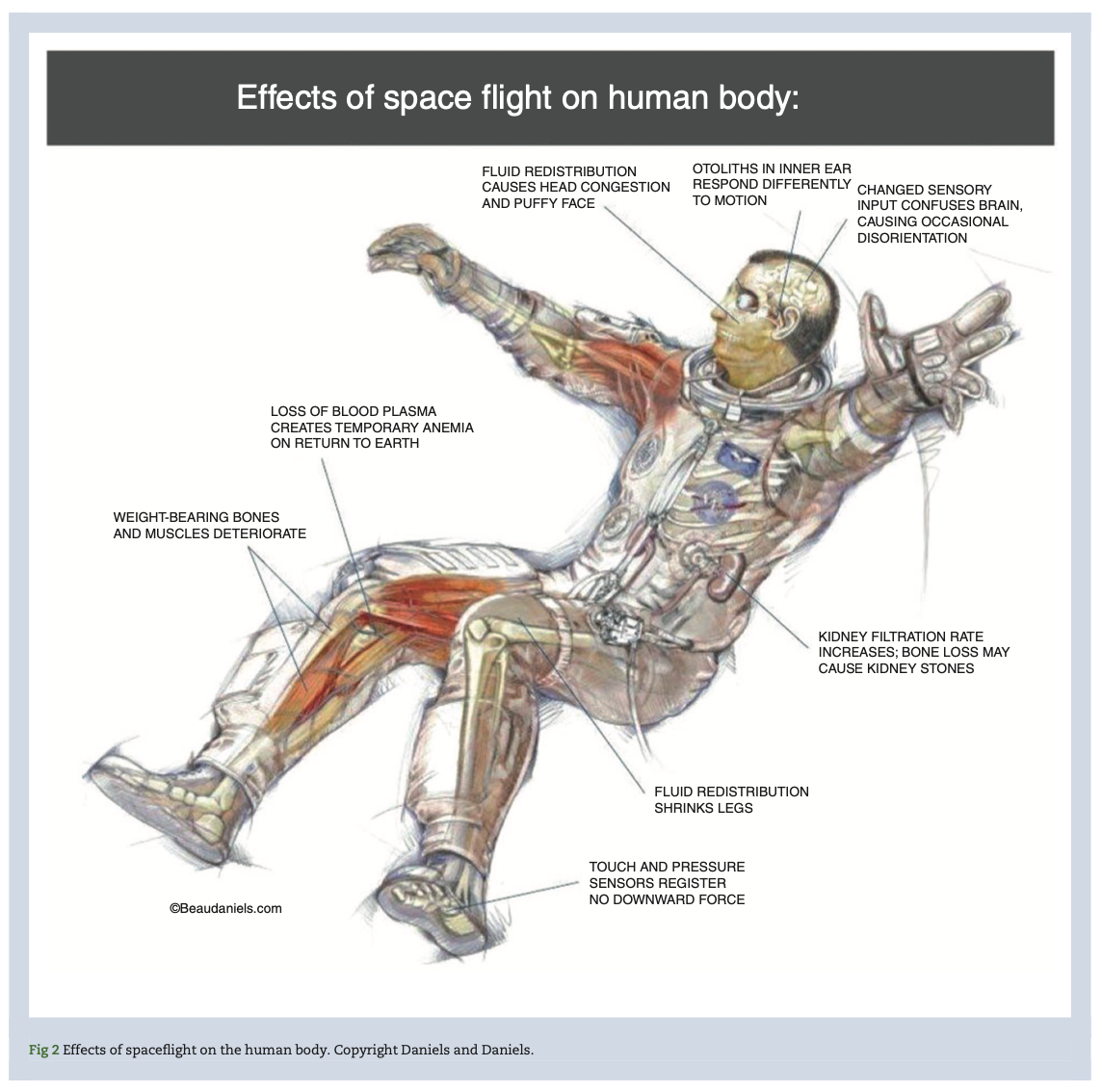
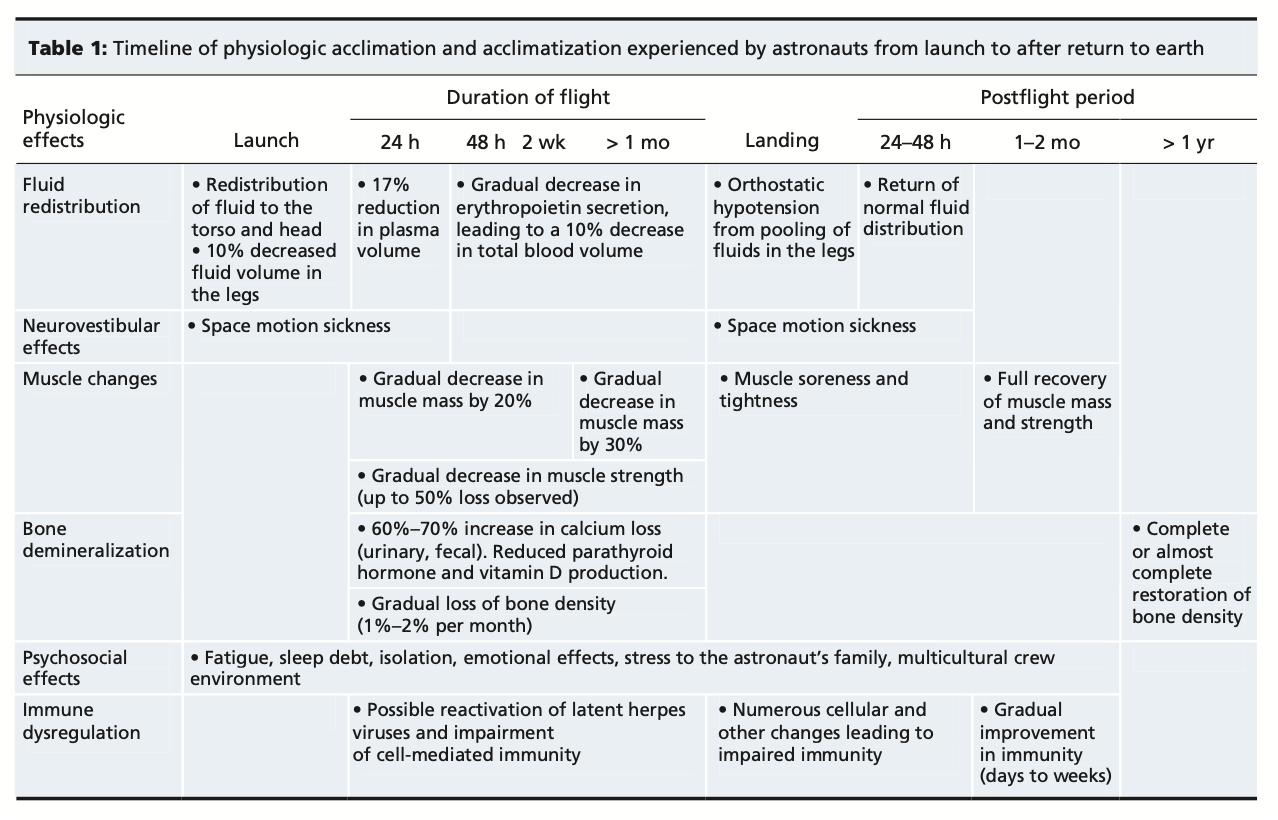
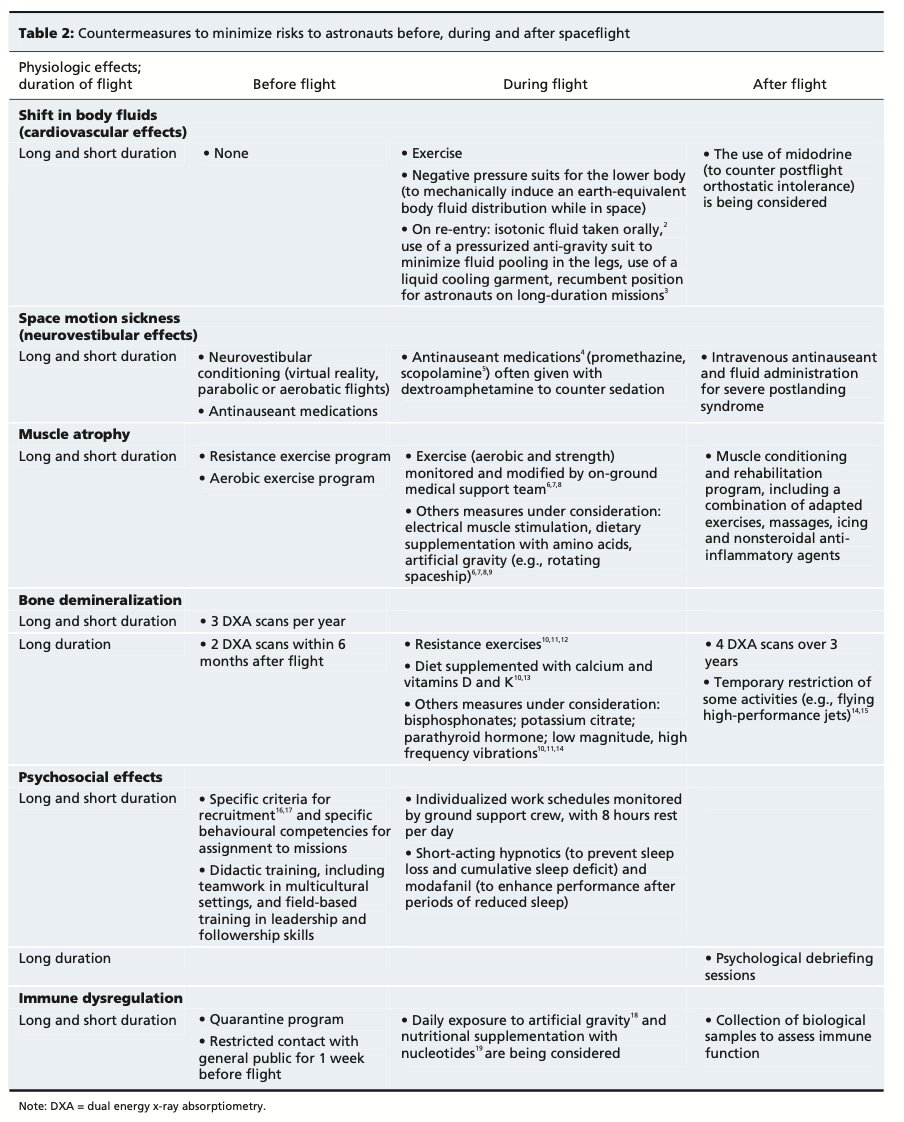
Conclusion
A mission to Mars is expected to take nearly three years, with six months in transit one-way. Only eight people have ever spent more than 300 consecutive days in space. We still have many unanswered questions about the effects of long-term space flight, whether the rate of physiologic changes accelerate over time, how to address medical and surgical, and if we can develop the appropriate countermeasures to keep our courageous explorers alive. More research is obviously required.
Most importantly, we have to acknowledge the existence of unknown unknowns: problems we cannot anticipate, but will require creative and daring solutions in the most remote, lowest-resource, and unforgiving locations that humans have ever dared to venture. Space exploration is not for the meek, the reckless, or the unprepared.
References
- Hodkinson PD, Anderton RA, Posselt BN, Fong KJ. An overview of space medicine. Br J Anaesth. 2017 Dec 1;119(suppl_1):i143-i153. doi: 10.1093/bja/aex336. PMID: 29161391.
- Williams D, Kuipers A, Mukai C, Thirsk R. Acclimation during space flight: effects on human physiology. CMAJ. 2009; 180(13):1317-1323. doi:10.1503/cmaj.090628
- Patel ZS, Brunstetter TJ, Tarver WJ, Whitmire AM, Zwart SR, Smith SM, Huff JL. Red risks for a journey to the red planet: The highest priority human health risks for a mission to Mars. NPJ Microgravity. 2020 Nov 5; 6(1):33. doi: 10.1038/s41526-020-00124-6. PMID: 33298950; PMCID: PMC7645687.
- Strollo F, Gentile S, Strollo G, Mambro A, Vernikos J. Recent Progress in Space Physiology and Aging. Front Physiol. 2018 Nov 12;9:1551. doi: 10.3389/fphys.2018.01551. PMID: 30483144; PMCID: PMC6240610.
- Norsk P. Cardiovascular and fluid volume control in humans in space. Curr Pharm Biotechnol. 2005 Aug;6(4):325-30. doi: 10.2174/1389201054553734. PMID: 16101471.
- Antonutto G, di Prampero PE. Cardiovascular deconditioning in microgravity: some possible countermeasures. Eur J Appl Physiol. 2003 Oct;90(3-4):283-91. doi: 10.1007/s00421-003-0884-5. Epub 2003 Jul 8. PMID: 12851824.
- Morphew, ME. Psychological and human factors in long duration space flight. McGill J Med. 2001; 6:74-80. doi.org/10.26443/mjm.v6i1.555
- NASA. What happens to the human body in space? https://www.nasa.gov/hrp/bodyinspace. Accessed April 15, 2022.
- Prisk GK. Microgravity and the respiratory system. Eur Respir J. 2014 May;43(5):1459-71. doi: 10.1183/09031936.00001414. Epub 2014 Mar 6. PMID: 24603820.